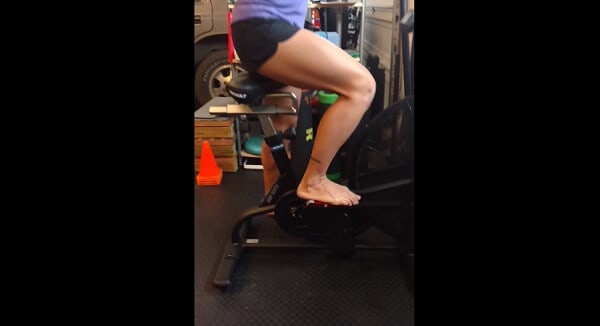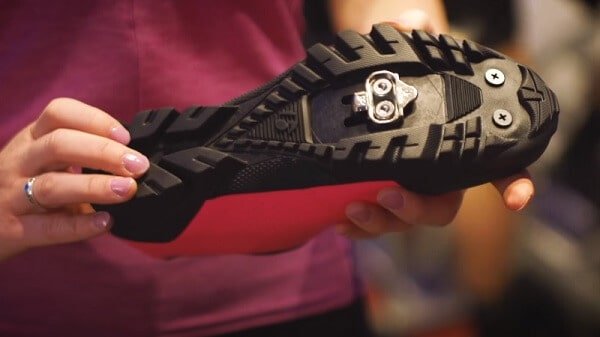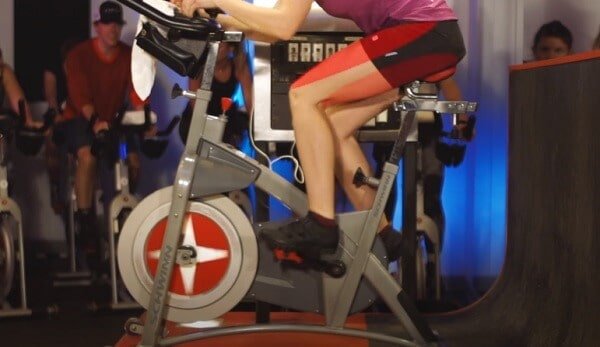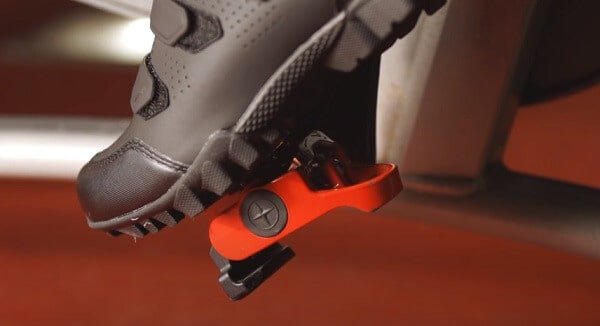Yes you can. But you have to take a few precautions to protect your feet from damage and fatigue. On the other hand, the general consensus is that it is best to wear some kind of footwear or, if possible, clip-in cycling shoes for best performance and comfort. Unsurprisingly, while both sides of the aisle have solid arguments, having footwear takes the lead in the majority of the cases.

While barefoot running may be a common scene in many places, barefoot cycling however may be a bit problematic if not done in very specific and proper ways.
In this article, we will be discussing how you can ride your exercise bike without shoes, but also look into the disadvantages of doing so and how these can be overcome with cycling specific shoes.
Using an Exercise Bike Without Shoes
Many argue that being barefoot is the natural state of the human body. You have ran and rode on your bicycle barefoot as a child, but how does that translate now that you are an adult?
Let us look at some benefits of using an exercise bike without shoes:
You can achieve a more natural pedaling motion.
There is nothing between you and the pedals to steer your feet away from following its own natural motions. Whereas clipless shoes rigidly hold your feet to the pedals and define foot movement, both upwards and downwards.
Open Air Protection
Adapting your body to your environment is never a bad thing. Keeping your feet bare while you are pedaling will expose them to the elements. This can eventually make them stronger and less susceptible to harsher conditions.
Get a More Confident Footing
The more you work on your bare feet, the more confident you will get on your footing. Your balance and stability will improve.
[Source]
But on the flipside, your feet will be exposed to certain amounts of discomfort and fatigue:
- Bad foot positioning and posture. Your feet and legs will feel numb and uncomfortable after long sessions.
- Even with flat pedals, the edges will still dig into your feet when you go hard or while braking.
- Nothing is stopping your feet from slipping off. Lower friction between your feet and flat pedals may make your foot slip and hit the frame of your exercise bike, leading to injuries.
- Speaking of flat pedals, most exercise bikes do not come with them out of the box. You may have to make a separate purchase. Commonly exercise bikes have plastic or metal spikes on them to provide more grip, some spinning bikes even come with clipless pedals. This also means that manufacturers of exercise bikes expect you have some kind of footwear on while using their equipment.
Funnily enough, all of these disadvantages can be overcome with the simple addition of a pair of cycling shoes to your routine.
Benefits Of Using Indoor Cycling Shoes On Your Exercise Bike
While you can use any old (or new) pair of sneakers for your indoor cycle, the benefits of actually using a pair of cycling shoes are exponentially greater.
Like regular cycles, many exercise bikes offer ‘clipless’ style pedals for their machines. The pedals ‘clip-on’ to the cleats attached to the cycling shoe to hold your feet in place.
A quick Tutorial on how to clip in your indoor cycle:

That said, let’s see some of the benefits that come with wearing cycling shoes on your exercise bike:
1. Power Transmission Efficiency
Your feet, with all its tissues and tendons, are very soft and flexible. So when you exert power to your feet, much of it is absorbed by them and very little goes into the pedal themselves.
Your regular sneakers, with their flexible rubber soles, are a bit better but achieve similar results as going barefooted.
Cycling shoes, on the other hand, have very stiff soles, especially the road variant of cycling shoes. This high stiffness of the sole enables more efficient power transfer from your leg muscles to the pedals, without any wasted movement or absorption of energy.
This makes it easier to pedal as you will now need to exert less effort to move, and even find confidence to move on to higher resistance levels.
2. Proper Alignment/Posture
Going barefoot or wearing regular sneakers will push you to always be conscious of your footing on the pedals.
Cycling shoes, however, will allow you to clip-in and lock your feet into place, restricting accidental lateral movements (slipping) of your feet on the pedals. On top of that, the clipped shoe will keep your feet static and aligned to the pedals throughout its full motion (360°).
This will heavily reduce the fatigue you feel on certain muscles after a rigorous exercise session, if any.

3. Promotes Muscle Growth
Speaking of muscles, having the correct posture on your exercise bike will help you to easily target your leg muscles for growth.
Your core and glutes will be more efficiently utilized and will also aid you to reduce stress on other parts of the body. But the most affected muscle will definitely be your calves. You can see good build up just after a few weeks of exercise.
All of this put together will see you have a much more fruitful and efficient sweat session.

4. Prevents Injuries
Perhaps the biggest pro the cycling shoes provide to your workout session is comfort. This added comfort can be directly translated to the prevention of injuries which are all too common in any workout environment that uses exercise equipment. In this case, the exercise bike.
Some of the most noticeable improvements are:
- Lower chances of cramping. The static alignment of your feet will heavily reduce stress to your calves preventing any chance of them cramping out in a vigorous session.
- Lowers knee pain. Preventing excessive lateral movements of the feet and knees will drastically reduce the chances of suffering knee pain, which are otherwise commonly attributed to cycling with a bad posture.
- Takes pressure off your back. Keeping your feet flat on the pedals will help you activate your glutes much easily. This will remove a lot of pelvic shifting from the equation reducing the chances of getting lower back pain.

Frequently Asked Questions
Q1) Is there a difference between indoor and outdoor cycling shoes?
Ans.: For turbo trainers or exercise bikes with clipless pedals, the shoes that go on them are fundamentally the same as outdoor cycling shoes.
There are two types, however, depending on their cleat style:
- The typical road bike type with 3-bolts.
- The typical MTB style with 2-bolts.
Some indoor turbo bikes offer pedals for both types, but it is still good to be aware.
Q2) When should I replace my indoor cycling shoes?
Ans.: If maintained well, you may never have to replace your indoor cycling shoes.
The only section that is being impacted are the cleats under your shoes, for which it is recommended that you replace them after every 3000 to 5000 miles on your exercise or spinning bike.
Final Words
While going barefoot anything may be the natural state of the body, barefoot cycling is not meant for everyone.
Even though you can go barefoot on your exercise bike, the benefits of getting yourself a pair of cycling shoes for the same purpose is far greater.
More comfort, more efficiency and more performance.

